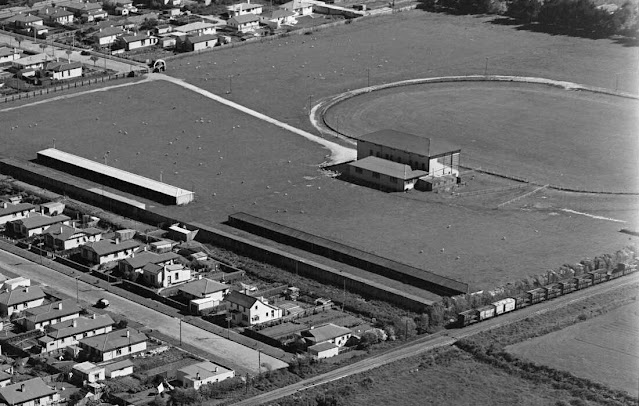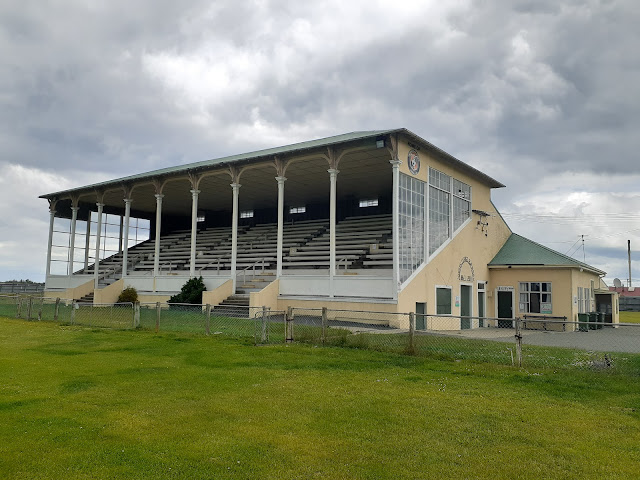North Otago A&P Showground and railway siding. November 1956. Care of the National Library of New Zealand - Oamaru Woollen Mills, Otago. Whites Aviation Ltd.
The annual A&P shows held throughout New Zealand are a highlight for rural communities and provide an opportunity for farmers and 'townies' to come together. The shows are firmly focused on agriculture and farming and feature many events and competitions involving animals. Today all of these animals arrive in horse floats, trailers, utes and stock trucks but in the past many of the animals arrived by rail.
Formed in 1863, the North Otago Agricultural and Pastoral Association is one of New Zealand's oldest A&P Associations. The show grounds off Ettrick Street in Oamaru North has been the home of the North Otago A&P Association since 1907.
There have been annual A&P shows held at the show grounds every year with only a handful of shows missed due to world wars, the 1918 influenza pandemic and the recent COVID 19 pandemic.
The show grounds were not just used for the A&P shows but were also used for military exercises and camps with the siding available for special troop trains.
To serve the show grounds, New Zealand Railways constructed a platform, siding and loading bank on the South Island Main trunk north of the Oamaru railway station. Opened on the 20th of October 1908, the station was called Oamaru Show Grounds.
I haven't been able to find to much information about the station or the siding but I did find a plan of the sidings in the Archives New Zealand Dunedin Office dated 1933 showing the layout of the siding, loading bank and platform.
The siding was closed to traffic on the 30th of November 1963.
The Oamaru Show Ground siding was located north of Oamaru railway station between the Foyle Street and Caledonian Street railway crossings.
While passing through Oamaru recently I took the opportunity to look at the old siding site to see what I could find. The answer was almost nothing. There is no evidence of the platform or loading bank however you could see where the ground had been built up next to the main line for the siding.
I started at the northern end of the old siding site at the Caledonian Street railway crossing.
Looking north from the Caledonian Street railway crossing. 25/11/22.
The northern turnout for the siding was located just south of the Caledonian Street railway crossing. You could see where the ground to the west of the main line had been built up for the siding.
Looking south from the Caledonian Street railway crossing. 25/11/22.
Looking south from the southern end of the former siding. Note the old grandstand in the show grounds. 25/11/22.
Looking south along the former siding. 25/11/22.
The southern turnout for the siding was at the end of Lynn Street and to the north of the Foyle Street railway crossing.
Looking north from the Foyle Street railway crossing. The southern turnout for the siding was located near the white house to the middle left of the photo. 25/11/22.
Looking south towards Oamaru railway station from the Foyle Street railway crossing. The Oamaru Woolen Mills is to the right. 25/11/22.
After finishing up at Foyle Street I headed into the show grounds to see if there were any remnants of the loading bank but there was nothing to see. The ground looked like it had been leveled sometime after the siding closed.
I was able to get a photo of the historic grandstand. The 1200 seat grandstand was designed by J.M Forrester, son of the famed Oamaru architect, Thomas Forrester.
Oamaru Show Grounds grand stand. 25/11/22.
The show grounds are still in regular use with the annual A&P show, equestrian events and soccer. The show grounds are also a popular New Zealand Motor Caravan Association camping ground. Many of the covered pens and yards still remain.
For more information on the show grounds visit the New Zealand History page here.
Information for this profile came from the Dunedin Office of the New Zealand Archives, the New Zealand History website and the National Library of New Zealand website which you can find here.
And that's about it.

.jpg)







